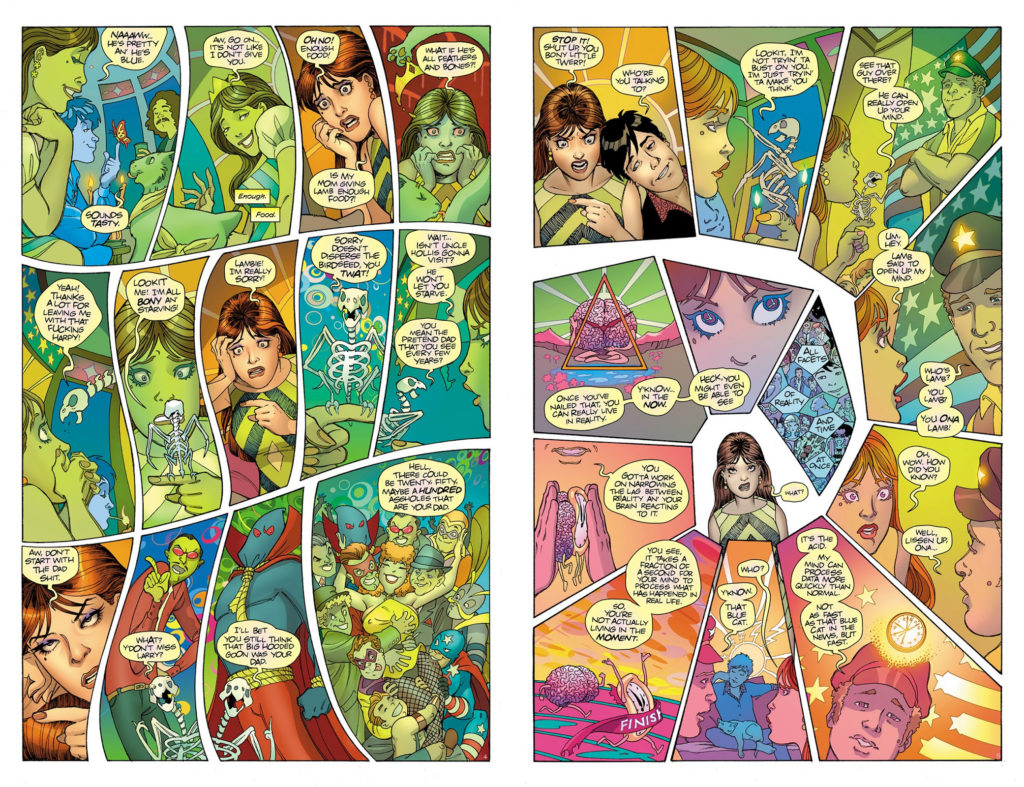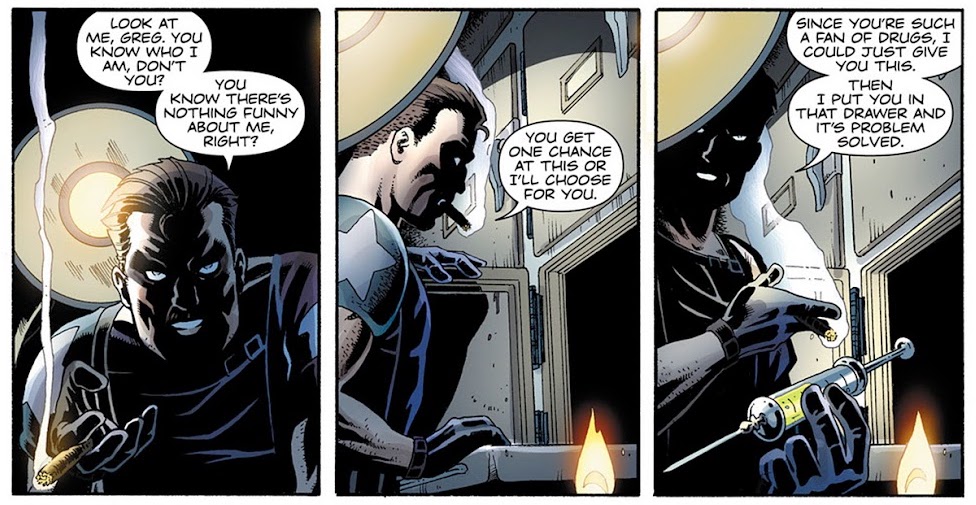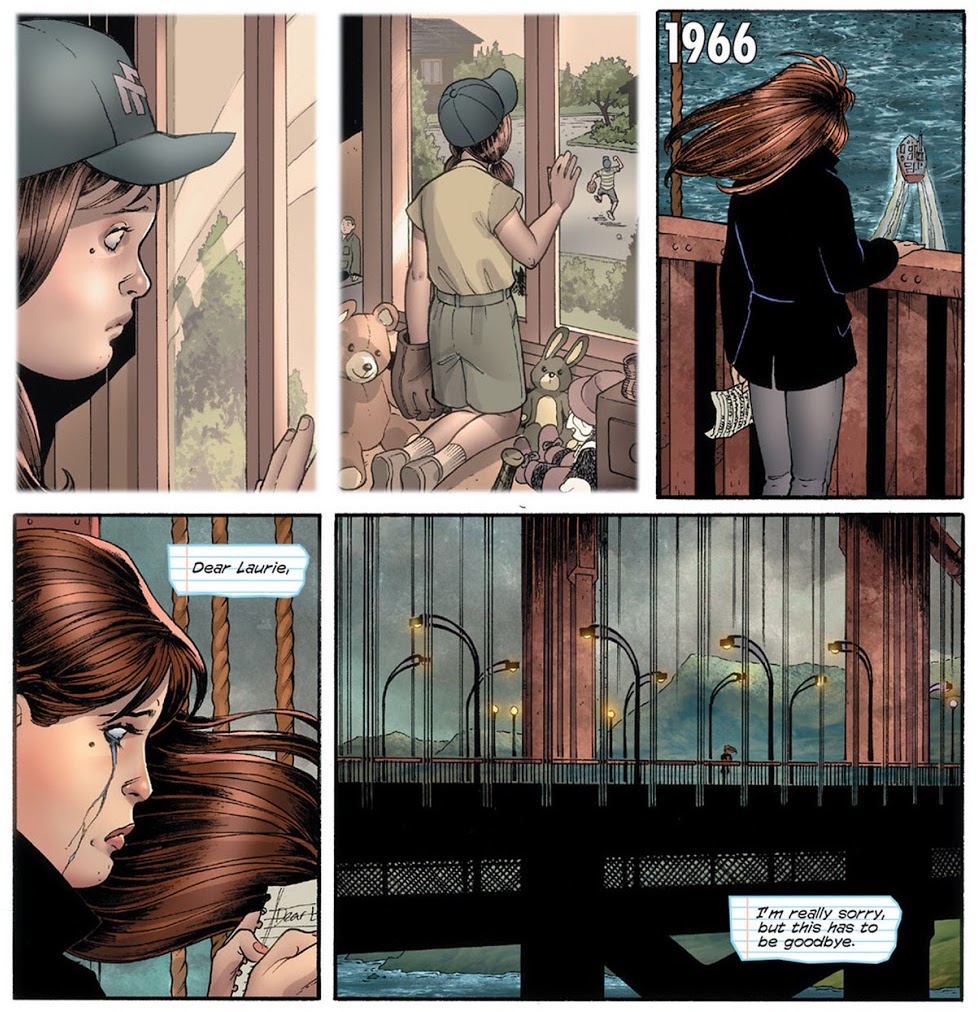Amanda Conner and Darwin Cooke’s Silk Spectre is, on some levels, the most faithful of the entire Before Watchmen project. Not only does it begin with a reference to a scene from the original book — the breaking of the snow globe that is hijacked into Dr. Manhattan’s narrative in #9 — but Amanda Conner approaches the visuals of the whole thing with Dave Gibbons clearly in mind; it’s not just that she adopts Watchmen‘s nine panel grid for the majority of the series (There’s one sequence where she breaks the format, and it’s both smart and cute; as Laurie gets high on LSD, the format starts literally falling in on itself), she’s clearly paid attention to Gibbons’ eye throughout the entire thing, and works to recreate his staging in a number of places. Of all the Before Watchmen books, Silk Spectre feels like the one that has spent the most time actually paying attention to Watchmen.

It feels strange to call Conner the unsung hero of Silk Spectre; she co-wrote it with Cooke and drew it, after all. Her’s is the largest contribution to the series, and yet, somehow I feel that she was nonetheless overshadowed by Cooke upon release. Comparing Silk Spectre with Minutemen, it’s clear that Conner was an active voice in writing the book — both in terms of overall tone and individual charactertization, this book reads very differently from Cooke’s solo series.
It’s more fractured and less chronological (More of the Moore Watchmen influence, again), less insular and more curious and concerned with the outside world rather than the internal narrative of its leads — as the original Watchmen explored the 1980s, this takes place for the most part in 1966 San Francisco, with Laurie dropping out into a sanitized version of the counter culture — and, ultimately, more willing to allow its characters to be complicated and contradictory without smoothing out the edges for readers. Once again, it feels more true to what Moore and Gibbons were aiming for in the original book.

It’s tempting to say that this series outstrips its predecessor in a couple of ways, which would be entirely unfair — not only does Silk Spectre have different ambitions than Watchmen, it’s noticeably less ambitious (Although, I hasten to add, I don’t mean that as an insult in any way; Watchmen‘s ambition is its undoing in many ways, for me). Nonetheless, Silk Spectre‘s characters feel genuinely complicated and alive for me in a way that Watchmen‘s never do, with the latter book feeling the hand of its writer all too clearly, shuffling pawns around the board the entire time. Similarly — and perhaps sensibly, considering it’s the sole female-led Watchmen project — it manages to offer up the most three-dimensional, non-cliched women in the entire franchise. Not that that’s hard; Watchmen — the original book and also the larger storyline with all of this Before Watchmen ancillary material — is depressingly, claustrophobically, male.
The teenage Laurie is at the center of Silk Spectre, and Conner and Cooke lay groundwork for Watchmen that deepens her portrayal in that book significantly, both in terms of her complicated relationship with her mother, but also the ways in which her actions in the mid-80s are fueled by a more optimistic, stubborn and ultimately tragic self from two decades earlier. Sally, too, benefits from being shown as something other than the broken figure she comes across as in Moore and Gibbons’ work; there’s something unsettlingly rewarding about seeing her actively being a complicated figure who, over and over again, demonstrates how difficult she is to love, instead of simply having other characters tell the reader in pointed terms.

(In this, Silk Spectre completes a makeover started in Minutemen, in which Sally’s relationship with Larry is flipped so that she’s seen as the dominant one with Larry far more of a nebbish background figure than he comes across in the original Watchmen. Stripping one layer of victim away from Sally sits easier with me than I suspect others would feel, if only because the women in Watchmen have always felt particularly artificial and “male-gaze”-y in my eyes; YMMV, as the internet reminds us.)
Silk Spectre is far from perfect — the analogies of pop culture figures feels really strange and cowardly, especially given their importance to the overall plot, and it doesn’t get around to finishing its thoughts on some of the themes raised early on, particularly on how Sally’s sexuality informs Laurie’s behavior — but it’s probably the best of the Before Watchmen books on a number of levels. That’s not intended as merely faint praise; it’s a solid showcase for Conner not just as artist, but as writer, as well. Laurie is perhaps the most absent of the core Watchmen cast, but this mini feels like the showcase she deserved all along.


This is my first reading of Before Watchmen, thanks to the magic of Hoopla and the encouragement of Wait, What?
Damn you, Graeme McMillan. I can’t believe I’m reading this morally gray “art.” I probably fall closer to Jeff in my love of Moore and my willingness to forgive Watchmen of all its sins due to its formal mastery and genre commentary so I’m not surprised Cooke’s stuff fell flat for me. All his warmed over nostalgia seemed overpowered by the racism, homophobia and sexism of the period in a way I just couldn’t get past in Minutemen.
QUESTION: can we excuse racist, homophobic, sexist content under the pretense of historic authenticity and “art” making a “statement,” or does perpetuating horrible content do nothing but desensitize and perpetuate horrible content? DISCUSS.
Totally agree that Silk Spectre was much more enjoyable and entertaining than it had any right to be.
So which book is up next? I’m loathing reading whatever’s next, but if I’m going to do this I may as well read along in step.
This almost made me want to read a Before Watchmen piece.
Laurie is such an enormous failure in Watchmen. The work doesn’t even gesture at her being anything other than a fantasy girlfriend for the male teenage reader. The entire Dan-Laurie romance is a tropetastic “nice guy” fantasy done absolutely without irony. This is a serious problem in a work that overtly prides itself on “subverting” tropes.
I think what I love about the Silk Spectre mini-series is that it feels like a John Irving novel. It has that same sort of feeling as a period piece, with complicated people leading unconventional lives. It deconstructs the genre of superheroes by pulling apart the “archie-ness” of relationships that typifies the soap opera element of Watchmen and gives it that spin of sentimental Charles Dickens-style writing that John Irving is famous for. I do appreciate the work put into this Before Watchmen story, but it feels out of place. I think, for my money, I’d rather it have been the origin of Dinah Lance, with the original Silk Spectre as Black Canary and Hollis Mason as Jay Garrick. It feels more at home in that story than it does in a prequel to Watchmen.
Love viewing it as a JSA story @gary — who’d serve as the Comedian?